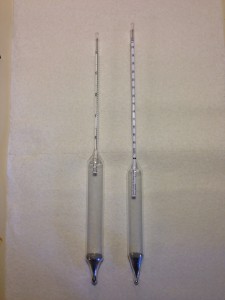 Last week, I described the basic idea behind the forced fermentation test. Basically, you overpitch a small sample of wort, and ferment it at high temperature. The sample will reach it’s final gravity (FG) before your main batch of beer. Knowing the FG of the sample will tell you what the FG of the your beer will be. This can be good to know when you are deciding whether to bottle. Here’s how to perform the test. [Read more…]
Last week, I described the basic idea behind the forced fermentation test. Basically, you overpitch a small sample of wort, and ferment it at high temperature. The sample will reach it’s final gravity (FG) before your main batch of beer. Knowing the FG of the sample will tell you what the FG of the your beer will be. This can be good to know when you are deciding whether to bottle. Here’s how to perform the test. [Read more…]
Forced Fermentation Test (II: Practice)
Forced Fermentation Test (I:The Basic Idea)
 Brewers, especially new brewers, may wonder what the final gravity (FG) of their beer should be. Perhaps their barleywine stopped fermenting at SG 1.022 and they are wondering if it’s done or the fermentation is stuck. This is something the FG alone can’t tell you.
Brewers, especially new brewers, may wonder what the final gravity (FG) of their beer should be. Perhaps their barleywine stopped fermenting at SG 1.022 and they are wondering if it’s done or the fermentation is stuck. This is something the FG alone can’t tell you.
Established recipes frequently list an expected FG, and these should be a good estimate if you follow the recipe exactly. If, however, you’re formulating your own recipe — or modifying an existing one — the FG depends on three main variables. First, every yeast strain has a different range of apparent attenuation. Secondly,grain bills can be mashed to yield more or less fermentable worts. (Likewise, different malt extracts yield worts of differing fermentabilities.) And finally, some kettle adjuncts are more or less fermentable than wort made from mashed grains or dissolved malt extract. Table sugar (sucrose), for example, is 100% fermentable. In contrast, milk sugar (lactose) is not fermentable by brewers yeast. Although it may be possible to calculate a likely FG, you can determine experimentally what your FG will likely be with the forced fermentation test. [Read more…]


Recent Comments